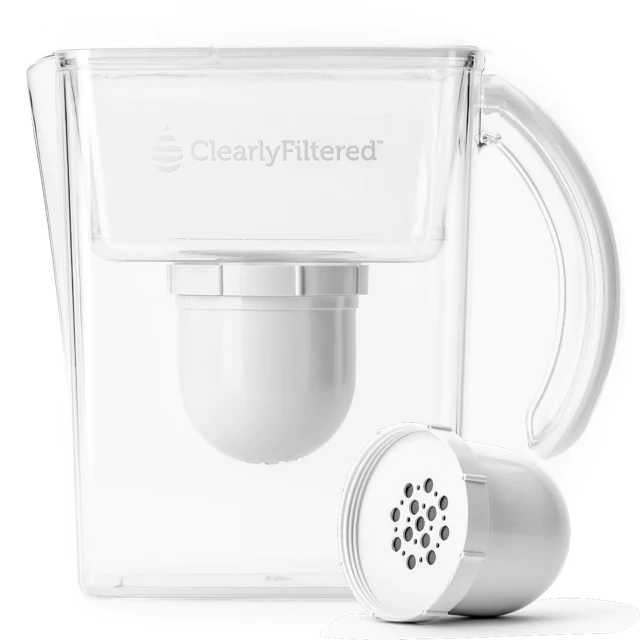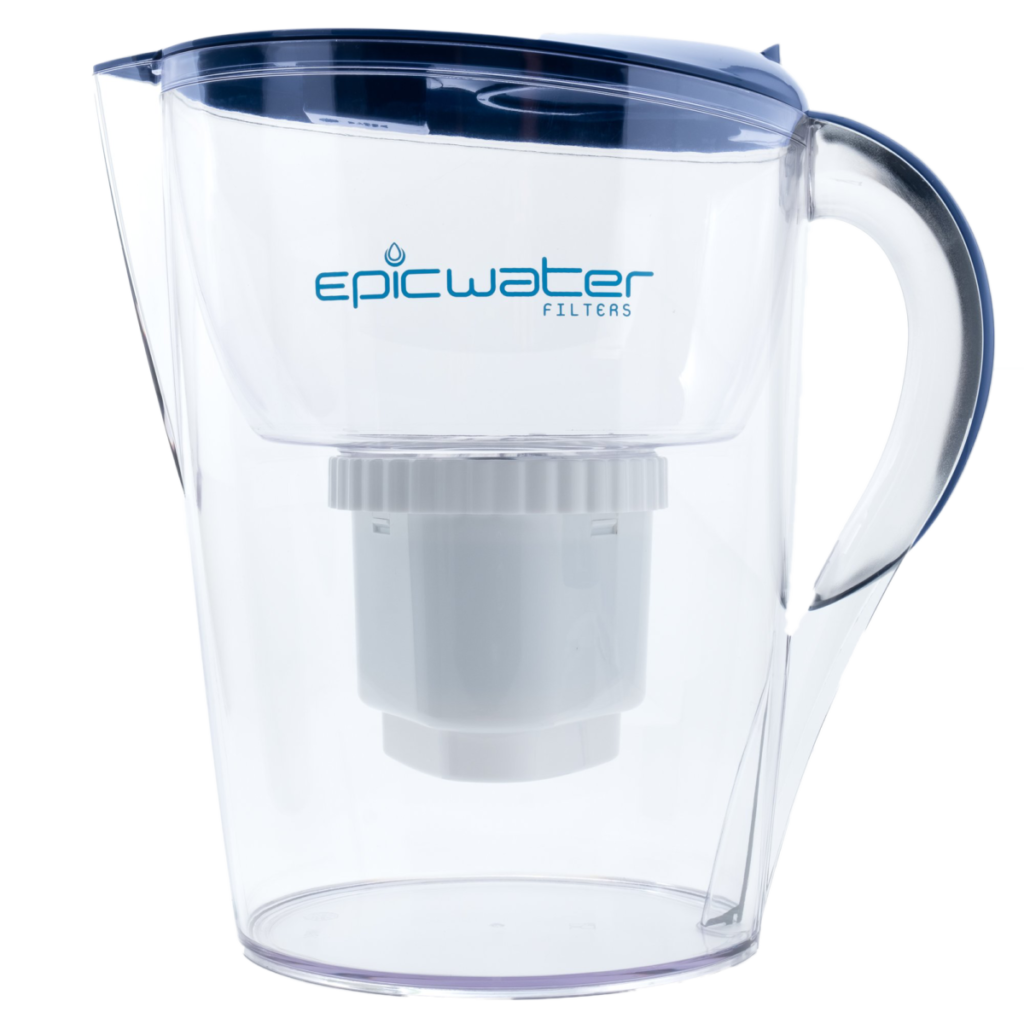Have you ever heard about brain-eating amoeba living in tap water? Well, it’s true. However, it turns out not all water filters remove amoeba but it’s easy to learn which ones do. Here’s what you need to look for.
Water filters that remove amoeba are NSF 53 or NSF 58 certified and/or have an “absolute” pore size of 1 micron or smaller. This includes reverse osmosis systems and some brands of water filter pitchers.
To give you a better idea on amoeba, we have compiled a TON of information on which water filters won’t let them through, and some specific filters proven to remove amoeba. We’ll also cover how big amoeba actually are, which amoeba are dangerous, if you can get infected from drinking contaminated water and how to protect yourself when you’re replacing a used water filter cartridge. And much more – enjoy!
Which water filters remove amoeba?
Clearly Filtered pitchers is the only brand of water filter that specifically states they remove Amoeba.
However, here’s what to look out for.
What to look for in a filter
Identifying water filters that can remove amoebas is fairly straightforward, if you know what to look for.
The CDC has made some rock-solid recommendations on which type of water filters you should look for to remove amoeba.
The first thing to check is does product have a National Sanitation Foundation (NSF) certificate:
There are two types of NSF certificates that some water filter and water purifier companies choose to carry on their products. The thing is, testing for this certification is VOLUNTARY, so you won’t find them on every product. These include:
- NSF 53 – relating to the standard for point-of-use water FILTERS or point-of-entry WHOLE HOME water filter systems.
- NSF 58 – relating to the standard for point-of-use REVERSE OSMOSIS (RO) systems
So, if you see “NSF 53” or “NSF 58” on the product label or the company states their products are NSF certified, this means the product has been rigorously tested by an independent American National Standards Institute (ANSI)-accredited testing organization.
However, NSF certification does not relate specifically to removing amoeba. Certification means the product does what the company is claiming it can do (relating to product material safety, structural integrity and performance claims regarding the removal of specific health-related contaminants).
The second thing to check is that the water filter has an absolute pore size of 1 micron or smaller.
Micron pore sizes of filters, purifiers or reverse osmosis systems relates to what can and cannot get through. The lower the micron number the smaller the particulate size that it will remove.
There are two ways a water filters pore size can be labelled (or graded):
- “Absolute”
OR
- “Nominal”
If you thought the word absolute sounds better than nominal, you would be correct!
When it comes to filtering out dangerous amoeba, such as Naegleria fowleri, the CDC recommends using water filters with an “absolute 1-micron pore size” or smaller.
According to the CDC guide to water filters, an absolute 1-micron pore size water filter will MORE CONSISTENTLY remove nasties from water, including things like Cryptosporidium, compared to a nominal 1-micron pore size filter.
To put this in perspective, some nominal filters have been found to still allow 20-30% of 1-micron particles (or larger) to pass through, whereas most absolute filters remove over 99.9% of 1-micron particles.
Which water filters can you trust?
Reverse Osmosis Systems
Reverse osmosis systems are one of your best bets in protecting you from amoeba. RO systems will typically have the NSF 58 certification and an absolute micron pore size of less than 1. In fact, many RO Systems have micron filter sizes of 0.001 (that’s 100 times smaller).
Filter Pitchers
For filter pitchers, you really can’t go past the Clearly Filtered Pitcher, briefly mentioned earlier, as it’s the ONLY filter we have found that has been directly tested to remove >99.99 % Amoeba from water.
Importantly, the Clearly filtered water bottles, undersink filters and refrigerator filters DO NOT specify that they remove amoeba. So, if you are at all concerned, just go with the Clearly Filtered Pitcher to be completely safe.
I would love to say that there are many more pitcher brands that have been tested to remove Amoeba but, at the time of writing, there are unfortunately no others. However, I will certainly add them to this post if and when they become available.
Another great option is the Epic Nano Water filter pitcher.
The Epic Nano is one of the ONLY filter pitchers that can remove harmful bacteria and viruses from water. It can also remove waterborne cysts – a non-infectious life stage of a parasitic amoeba.
Other Options
For all other types of water filters, take a close look over the label. If it says NSF 53 (or NSF certified), you can feel safe the product has been tested according to the products performance claims.
You may also notice some products have “cyst removal” or “cyst reduction” like the Epic Nano. Amoeba can also travel as cysts, but don’t worry too much as you can’t get infected directly by amoeba when they are in the cyst stage.
Not all water filters or purifiers will have the NSF certification however, so look for products with an absolute 1-micron filtration rating. If you are concerned about amoeba, don’t settle for anything that states it has a “nominal” filtration pore size because you just don’t know what it might let through.
Here are some (not all) types of water filters and how they measure up.
Does Brita filter amoeba?
In 2018, the International Journal of Infections Disease published a fatal case of amoebic, Balamuthia mandrillaris, brain infection after a 69-year-old woman used Brita filtered tap water in a Neti pot.
Brita filters do not filter amoeba, and Brita filtered water should not be used for a Neti Pot.
All Brita water filters carry the NSF/ANSI 53 certification. However, none of their filters have an absolute pore size rating and instead they use a particulate class system which is essentially the same as a nominal pore size rating.
Under this system, each filter only has to reduce the particulate matter by 85% of the particle size to meet the minimum requirements as follows.
| Product | Class | Particle size | Minimum reduction requirement |
| Brita Longlast Filters | I | 0.5 to less than 1 micron | 85% |
| Brita Faucet Mount Filters | I | 0.5 to less than 1 micron | 85% |
| Brita Bottle Filters | VI | Greater than 50 microns | 85% |
| Brita Stream Filters | VI | Greater than 50 microns | 85% |
Does Berkey water filter amoeba?
Berkey is a popular brand and boasts their filters are capable of removing 99.9999999% of all pathogens from water (yes that’s a real number), which is whey they refer to their systems as water purifiers not just water filters.
Importantly, these impressive results come from their in-house testing, not the NSF/ANSI standard that other reputable companies use for transparency. Berkey claim their testing far exceeds those of the NSF/ANSI standards – but they certainly don’t claim to remove amoeba.
Overall, it’s likely the Berkey filters, such as BLACK BERKEY filters, will remove amoeba. However, Berkey have chosen not to provide a micron rating for their filters and have not been tested to NSF/ANSI 53 standards, so we cannot confirm this.
Does Zero Water filter amoeba?
Zero water filters have the NSF 53 testing certification. A 5-stage filtering system is used in each of their three types of water filter types:
- Zerowater Tumbler water filters
- Zerowater Mini replacement filters
- Zerowater Pitcher/dispenser water filters
Stage 1 is a 20-50 micron filter (not small enough for filtering amoeba).
Stages 2-4 include carbons, suspended solid screens and resins to reduce heavy metals, but no micron sizes are provided.
Stage 5 is a 1-micron filter but there is no specification if it is absolute or nominal filtration.
Zero water do not claim to remove amoeba. Although they have a small micron filter size and carry the NSF 53 certification, I would not trust it entirely as there is no specification to an absolute micron rating. i.e. you can probably drink it, just don’t use Zero water filtered water in a Neti Pot.
Amoeba in your water filter replacement cartridge
When you are replacing your water filter cartridge remember that any amoeba or other nasties removed from the water are still on the filter itself. For this reason, you should only change a water filter if you are not immunocompromised and remember to wear gloves and wash your hands afterwards.
Does tap water have amoebas?
Although water treatment plants usually do a good job of killing everything that may exist in your drinking water supply, amoeba can still live and grow in places where water disinfection is reduced (e.g. water with minimal levels of chlorine or chloramine). This can include:
- Commercial water storage facilities
- Private water tanks
- Hot water heaters
- Household water pipes and sinks
- Hot tubs
- Swimming pools
Infection cases from tap water, from N. fowleri, have usually involved amoeba-contaminated tap water when it’s been used for things like sinus irrigation, such as with a “neti pot” (looks like a kind of tea pot) or in ritual nasal cleansing practices (Ref 1: Bartrand, Causey & Clancy 2014).
The list of fatal infection cases caused by exposure to N. fowleri in drinking water in the United States include:
- Arizona 2002 – two 5-year-old boys died from bathing in municipal tap water.
- Louisiana 2011 – two separate but fatal cases occurred after sinus irrigation using household tap water.
- Louisiana 2013 – one child died after playing on an outdoor water slide fed by household tap water.
- US Virgin Islands 2012 – one person died following a ritual nasal cleansing. However, the house water came from an untreated well and rainwater cistern. The home’s plumbing system was found to be colonized with N. fowleri (Ref 1: Bartrand, Causey, & Clancy 2014).
Florida 2020 – In early July, the Florida Department of Health (DOH) announced that one person contracted N. fowleri in the Hillsborough County.
Tap water infections from amoeba are rare.
However, people who wear contact lenses are in a higher-risk group for infection by the amoeba genus, Acanthamoeba spp., which causes a painful and sight-threatening eye disease, Acanthamoeba keratitis (AK) (Visvesvara, Moura & Schuster 2007).
In the United States, an estimated 1-2 people per million contact-lens wearers are infected with AK each year. It mainly comes from people washing their contact lenses in non-sterilized tap water and/or not keeping contact lens storage cases clean (Ref 10: Verani et al., 2009).
How big are amoebas?
The size of an amoeba varies between genus, but also at what point it is in its life cycle:
- Cyst – tough and more resistant to environmental conditions
- Amoeba – termed the “Trophozoite” stage; they are mobile, actively feeding and can therefore infect you.
- Flagellate – only N. fowleri has a flagellate stage, which makes them more mobile and can disperse further… YAY… ☹
Generally, you won’t find much difference between the species smallest cyst, trophozoite or flagellate sizes. We are only really interested in how SMALL amoeba can get as this is what will or will not get stopped by the water filter, purifier or RO system.
Although, N. fowleri has the smallest sized trophozoite (10 microns), nothing is 100% in nature so I certainly wouldn’t go and trust a water filter with a 5-micron pore size to necessarily do the job.
Here is a list of amoeba sizes at each stage in their life cycle:
| Genus | Cyst stage | Amoeba stage | Flagellate stage | Reference |
| Sappinia spp. | 15-30 microns | 40-80 microns | – | Visvesvara, Moura & Schuster 2007 |
| Balamuthia mandrillaris | 12-30 microns | 12-60 microns | – | Visvesvara, Moura & Schuster 2007 |
| Acanthamoeba spp. | 13-20 microns | 15-50 microns | – | Marciano-Cabral & Cabral 2003; Visvesvara, Moura & Schuster 2007 |
| Naegleria fowleri | 7-15 microns | 10-35 microns | 10-16 microns | CDC 2017b; Laseke et al., 2010 |
Can you become infected from drinking amoeba?
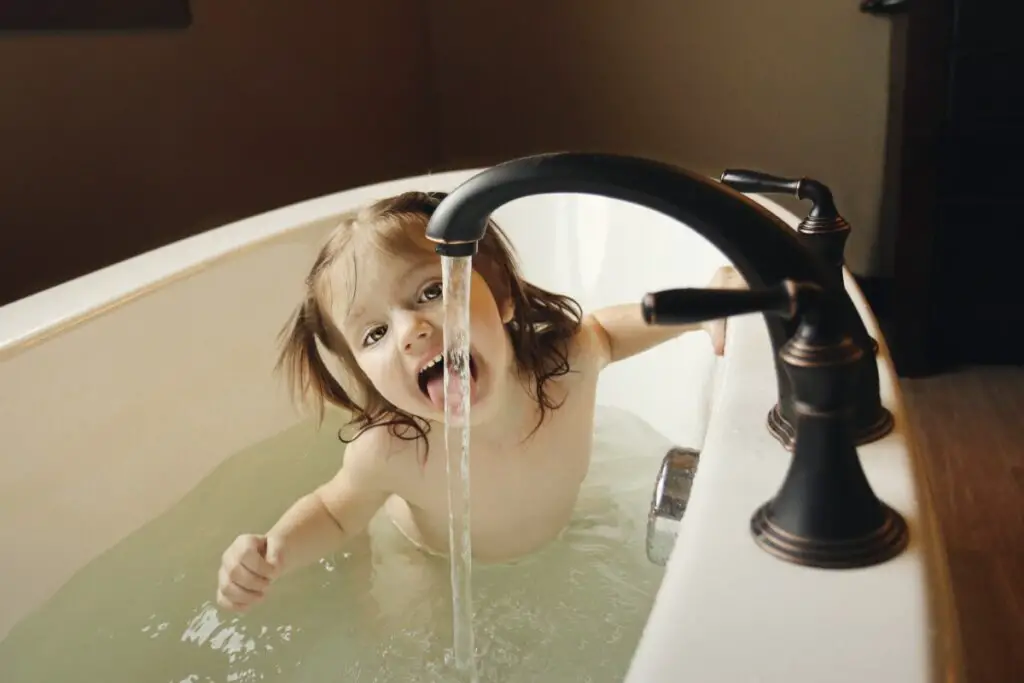
The CDC states you cannot get infected by the brain-eating amoeba, N. fowleri, by drinking water. Infection occurs when a person is exposed to amoeba-contaminated water that enters the nasal cavity (CDC 2017b).
Similarly, there are no reports of infection from drinking water containing Acanthamoeba spp., Balamuthia mandrillaris or Sappinia spp.
Which amoeba are dangerous to humans?
There are four Genus of amoeba that can infect and cause disease in humans:
- Sappinia spp.
- Balamuthia mandrillaris
- Acanthamoeba spp.
- Naegleria fowleri
Infection from amoeba is rare (in the United States, rare means infection occurs in less than 200,000 people). Amoeba are found worldwide and can be found almost everywhere that is wet and most species can also be found in soil or dust (Ref 9: Schimmel & Mehta 2020).
Exposure to amoeba usually occurs when people go swimming in lakes and rivers or inhalation of dust or aerosols containing amoeba. In fact, most people will be exposed to the Genus Acanthamoeba spp. at some point during their life but are unlikely to become sick (CDC 2017a).
Exposure to the species, N. fowleri, mainly occurs in areas of warmer fresh waters, such as lakes and ponds, hot springs, water heaters or even an inadequately chlorinated swimming pool. They just love the heat and that includes more southern areas of the U.S.
Sappinia spp.
Probably the least scary amoeba and includes the species, s. diploidea and s. pedate.
Fun facts:
- Only one case has ever been reported globally; A 38-year old Texan man suffered amebic encephalitis after a sinus infection.
- The amoeba species, s. diploidea, was originally implicated for hospitalizing the Texan (Gelman et al., 2001), but it was later found that the amoeba species to blame was s. pedate (Qvarnstrom et al., 2009).
Acanthamoeba spp. and Balamuthia mandrillaris
Both acanthamoeba spp. and b. mandrillaris are recognized by the CDC as capable of causing a fatal disease of the central nervous system called granulomatous amebic encephalitis (GAE). GAE infections are rare, usually fatal, and typically occur in people who are immunosuppressed, although healthy people may still become infected from b. mandrillaris.
Acanthamoeba spp. can also cause the eye disease, Acanthamoeba keratitis, also known as amoeba keratitis or (AK), primarily from incorrect washing by contact-lens wearers.
However, in September 2020 the New England Journal of Medicine reported that an 82-year-old man died from GAE after becoming infected by Acanthamoeba spp while potting plants.
Fun facts:
- Acanthamoeba spp. have caused 144 cases of GAE in the United States between 1955–2009
- B. mandrillaris caused 94 cases of GAE in the United States between 1974–2014
Naegleria fowleri
N. fowleri is what nightmares are made of – the amoeba is commonly referred to as the “brain-eating amoeba”.
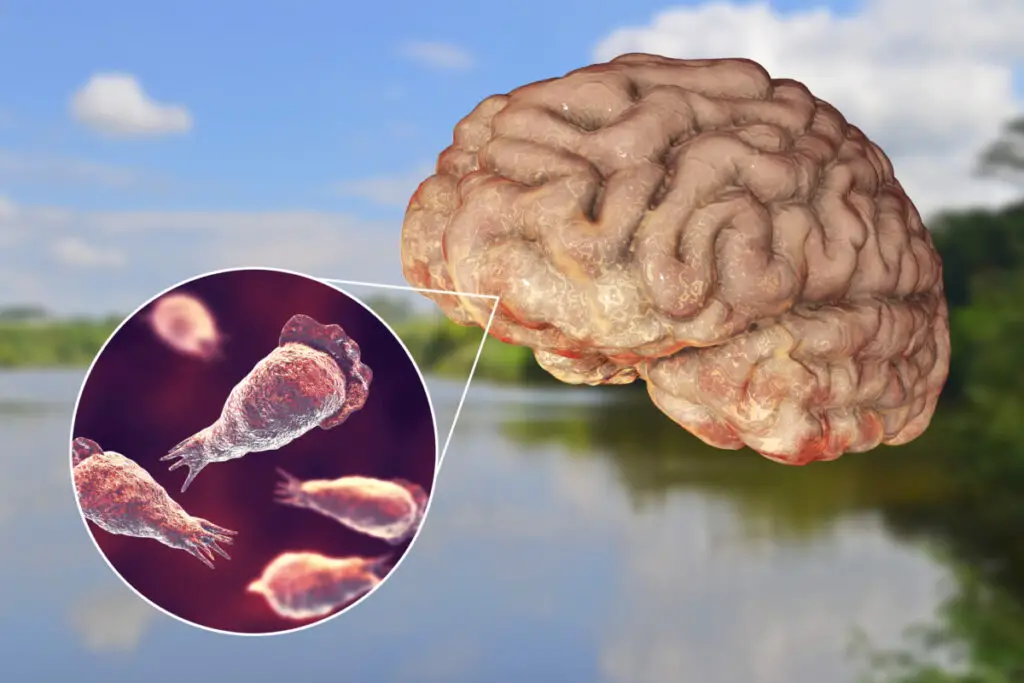
There are over 30 species of amoeba in the Genus Naegleria (Visvesvara, Moura & Schuster, 2007), but only one species, Naegleria fowleri, is identified by the CDC as causing a rare but serious and rapid-acting brain infection called primary amebic meningoencephalitis (PAM) (Ref 5: Laseke et al., 2010).
Fun facts:
- In the United States, N. fowleri has a known geographic pattern, occurring primarily in the warmer southern-tier states.
- From 1962–2020, 146 cases of PAM were documented in the United States, with the highest number found in Texas (39 cases) and Florida (36 cases) (see figure below for other U.S. infection cases).
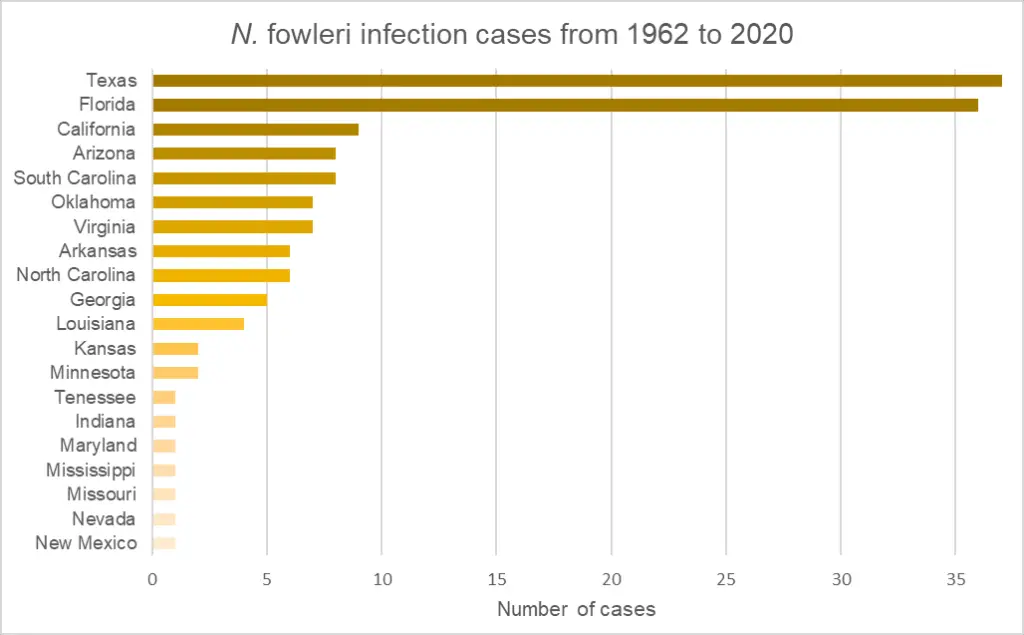
How long do you have to boil water to kill amoeba?
Water should be boiled for 1 minute to kill amoeba. However, at elevations greater than 6,500 feet (1,980 meters) water should be boiled for 3 minutes.
Can amoeba live in chlorinated water?
Chlorine is an efficient disinfectant that kills amoeba, which is one of the reasons it’s used in municipal water treatment plants and why it’s important to use chlorine or chloramine to properly sterilize your swimming pool or hot tub.
References
1. Bartrand, T.A., Causey, J.J. and Clancy, J.L., 2014. Naegleria fowleri: An emerging drinking water pathogen. Journal‐American Water Works Association, 106(10), pp. E418-E432. <https://doi.org/10.5942/jawwa.2014.106.0140>.
2. CDC 2017a, Parasites — Acanthamoeba — Granulomatous Amebic Encephalitis (GAE); Keratitis. <https://www.cdc.gov/parasites/acanthamoeba/index.html>
3. CDC 2017b, Parasites — Naegleria fowleri — Primary Amebic Meningoencephalitis (PAM) — Amebic Encephalitis. <https://www.cdc.gov/parasites/naegleria/pathogen.html>.
4. Gelman, B.B., Rauf, S.J., Nader, R., Popov, V., Borkowski, J., Chaljub, G., Nauta, H.W. and Visvesvara, G.S., 2001. Amoebic encephalitis due to Sappinia diploidea. Jama, 285(19), pp.2450-2451. <Amoebic Encephalitis Due to Sappinia diploidea | JAMA | JAMA Network>.
5. Laseke, I., Korte, J., Lamendella, R., Kaneshiro, E.S., Marciano-Cabral, F. and Oerther, D.B., 2010. Identification of Naegleria fowleri in warm ground water aquifers. Journal of environmental quality, 39(1), pp.147-153. <https://doi.org/10.2134/jeq2009.0062>.
6. Marciano-Cabral, F. and Cabral, G., 2003. Acanthamoeba spp. as agents of disease in humans. Clinical microbiology reviews, 16(2), pp.273-307. <DOI: https://doi.org/10.1128/CMR.16.2.273-307.2003>.
7. Piper, K.J., Foster, H., Susanto, D., Maree, C.L., Thornton, S.D. and Cobbs, C.S., 2018. Fatal Balamuthia mandrillaris brain infection associated with improper nasal lavage. International Journal of Infectious Diseases, 77, pp.18-22. <https://doi.org/10.1016/j.ijid.2018.09.013>.
8. Qvarnstrom, Y., Da Silva, A.J., Schuster, F.L., Gelman, B.B. and Visvesvara, G.S., 2009. Molecular confirmation of Sappinia pedata as a causative agent of amoebic encephalitis. The Journal of infectious diseases, 199(8), pp.1139-1142. <https://doi.org/10.1086/597473>.
9. Schimmel, M. and I. Mehta (2020). “Granulomatous Amebic Encephalitis.” New England Journal of Medicine 383(13): 1262-1262. <DOI: 10.1056/NEJMicm2002401>.
10. Verani, J.R., Lorick, S.A., Yoder, J.S., Beach, M.J., Braden, C.R., Roberts, J.M., Conover, C.S., Chen, S., McConnell, K.A., Chang, D.C. and Park, B.J., 2009. National outbreak of Acanthamoeba keratitis associated with use of a contact lens solution, United States. Emerging infectious diseases, 15(8), p.1236. <doi: 10.3201/eid1508.090225>
11. Visvesvara, G.S., Moura, H. and Schuster, F.L., 2007. Pathogenic and opportunistic free-living amoebae: Acanthamoeba spp., Balamuthia mandrillaris, Naegleria fowleri, and Sappinia diploidea. FEMS Immunology & Medical Microbiology, 50(1), pp.1-26. <https://doi.org/10.1111/j.1574-695X.2007.00232.x>

